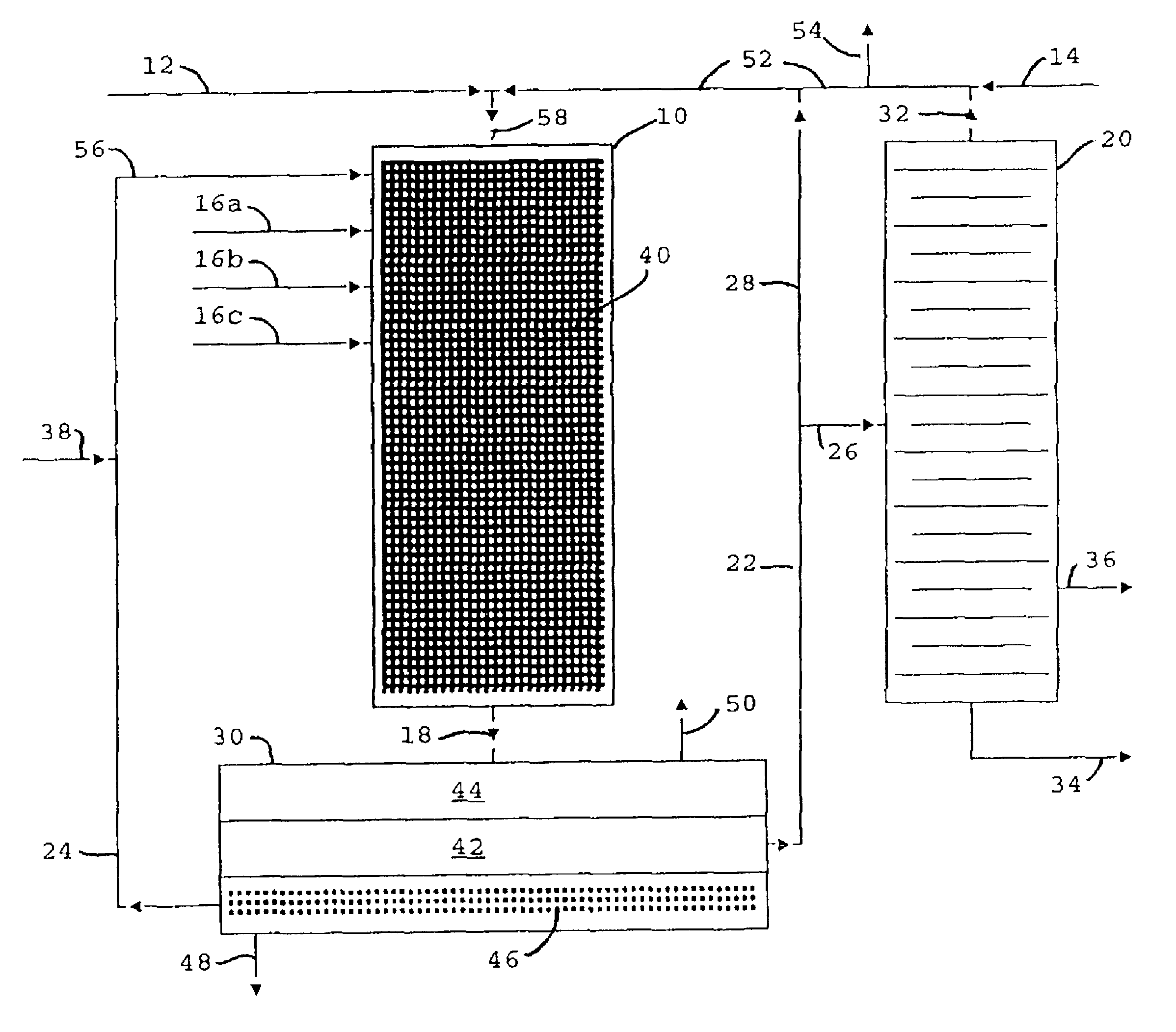Paraffin alkylation
a technology of paraffin and alkylation, which is applied in the direction of hydrocarbon preparation catalysts, physical/chemical process catalysts, naphtha treatment, etc., can solve the problems of no other process being as efficient and the process not being environmentally friendly, and achieves less cost, easy separation, and prevent side reactions
- Summary
- Abstract
- Description
- Claims
- Application Information
AI Technical Summary
Benefits of technology
Problems solved by technology
Method used
Image
Examples
example 1
Refinery C4 Olefins used asfeedstocksTo the Lab Unit:38% iB inLow iBtotal olefinsmethane0.020.00ethane0.000.00ethene0.000.00propane0.770.41propene0.140.16propyne0.020.00propadiene0.010.02iso-butane23.9147.50iso-butene0.9015.901-butene20.0210.491,3-butadiene0.020.19n-butane22.6310.79t-2-butene18.057.932,2-dm propane0.090.001-butyne0.000.01m-cyclopropane0.030.03c-2-butene12.095.431,2-butadiene0.000.013M-1-butene0.260.04iso-pentane0.980.021-pentene0.060.822M-1-butene0.010.01n-pentane0.010.03t-2-pentene0.000.08c-2-pentene0.000.00t-3-pentadiene0.000.08c-1,3-pentadiene0.000.00unknowns0.010.08100.00100.00
Comparison of Refinery produced Alkylate withLab Unit results using similar low iB C4 feedPlant APlant BLab 1Lab 2iC56.272.702.512.782,3-dmb4.052.842.803.02C61.631.191.001.152,2,3-tmb0.200.170.180.19C77.175.554.354.35TM C853.8861.7666.8466.93DM C812.2712.4712.6912.44TM C95.044.222.892.74DM C90.571.010.290.18TM C101.140.910.700.64UNK C100.510.540.290.29TM C110.990.770.690.71UNK C111.090.020...
example 2
Effect of Isobutylene (iB) on AlkyQualitylab 1100% iB38% iBlow iBiC53.663.972.782,3-dmb3.603.563.02C61.420.521.152,2,3-tmb0.400.230.19C75.275.084.35TM C850.7956.9566.93DM C811.7712.6412.44TM C96.074.222.74DM C90.580.450.18TM C102.061.330.64UNK C101.140.670.29TM C112.541.280.71UNK C111.000.000.00C128.308.994.60C130.070.000.00C140.280.140.00C150.120.000.00HV'S0.380.000.00UNK0.540.000.00sum100.00100.00100.00Av MW119.1117.3114.9Bromine no.˜1<1<1Total Sulfur ppm<10<10<10TOTAL % TM61.4663.7771.12TM C8 / DM C84.314.515.27TM C9 / DM C910.519.3410.08
example 3
Propylene + iC4 AlkylationSample Pointproductpropane0.01iso-butane9.25n-butane0.32iso-pentane0.97n-pentane0.002,3-dm butane2.072M-pentane0.303M-pentane0.14n-hexane0.002,4-dm pentane15.592,2,3-tm butane0.043,3-dm pentane0.01cyclohexane0.002M-hexane0.342,3-dm pentane48.971,1-dm cyclopentane0.003M-hexane0.352,2,4-tm pentane3.42n-heptane0.002,5-dm hexane0.372,4-dm hexane0.562,3,4-tm pentane1.522,3,3-tm pentane1.212,3-dm hexane0.642,2,5-tm hexane0.682,3,4-tm hexane0.132,2-dm heptane0.012,4-dm heptane0.032,6-dm heptane0.032,2,4-tm-heptane1.833,3,5-tm-heptane1.702,3,6-tm-heptane1.162,3,5-tm-heptane0.16tm-heptane1.002,2,6-trimethyloctane2.32C8s0.20C9s0.20C10s0.98C11s1.62C12s1.73C13s0.09C14s0.05C15s0.01unknowns0.01heavies0.00100.00
PUM
| Property | Measurement | Unit |
|---|---|---|
| Fraction | aaaaa | aaaaa |
| Fraction | aaaaa | aaaaa |
| Fraction | aaaaa | aaaaa |
Abstract
Description
Claims
Application Information
 Login to View More
Login to View More - R&D
- Intellectual Property
- Life Sciences
- Materials
- Tech Scout
- Unparalleled Data Quality
- Higher Quality Content
- 60% Fewer Hallucinations
Browse by: Latest US Patents, China's latest patents, Technical Efficacy Thesaurus, Application Domain, Technology Topic, Popular Technical Reports.
© 2025 PatSnap. All rights reserved.Legal|Privacy policy|Modern Slavery Act Transparency Statement|Sitemap|About US| Contact US: help@patsnap.com


